The Penile Cancer Treatment Market is estimated to be valued at USD 3.7 billion in 2025 and is projected to reach USD 13.8 billion by 2035, registering a compound annual growth rate (CAGR) of 14.0% over the forecast period.
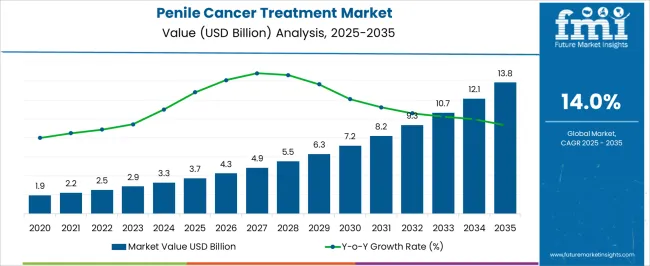
| Metric | Value |
|---|---|
| Penile Cancer Treatment Market Estimated Value in (2025 E) | USD 3.7 billion |
| Penile Cancer Treatment Market Forecast Value in (2035 F) | USD 13.8 billion |
| Forecast CAGR (2025 to 2035) | 14.0% |
The penile cancer treatment market is experiencing gradual growth, primarily influenced by increasing awareness, improved diagnostic methods, and the availability of advanced therapeutic interventions. Rising prevalence of penile cancer in certain regions, combined with growing initiatives to promote early detection, is driving the demand for effective diagnostic and treatment options. Clinical advancements in both surgical and non-surgical therapies are expanding the treatment landscape, providing patients with improved survival outcomes and reduced recurrence risks.
Governments and healthcare organizations are emphasizing screening programs and awareness campaigns to overcome stigma and ensure timely intervention. Investments in oncology research, along with the development of minimally invasive surgical techniques, are further shaping market trends.
As healthcare infrastructure improves in emerging economies and access to cancer care expands, the market is positioned for steady progression The growing role of personalized medicine and molecular diagnostics is also expected to pave the way for targeted therapies, providing new opportunities for innovation and adoption in the penile cancer treatment market over the coming years.
The penile cancer treatment market is segmented by type of disease, type of therapy, type of diagnostic test, and geographic regions. By type of disease, penile cancer treatment market is divided into Squamous cell cancer of penis, Adenocarcinoma of penis, Melanoma of the penis, Basal cell cancer of penis, and Sarcoma of penis. In terms of type of therapy, penile cancer treatment market is classified into Surgery (Cryosurgery, Laser), Radiation Therapy, Chemotherapy, and Biological Therapy. Based on type of diagnostic test, penile cancer treatment market is segmented into Biopsy, Ultrasound, Imaging tests, Computed Tomography (CT), Position Emission Tomography (PET), and Magnetic Resonance Imaging (MRI). Regionally, the penile cancer treatment industry is classified into North America, Latin America, Western Europe, Eastern Europe, Balkan & Baltic Countries, Russia & Belarus, Central Asia, East Asia, South Asia & Pacific, and the Middle East & Africa.
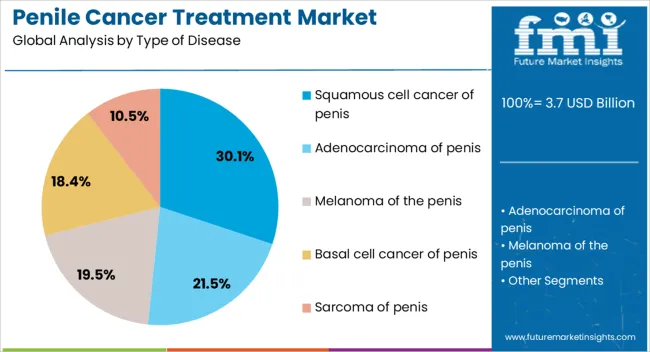
The squamous cell cancer of penis segment is projected to hold 30.1% of the penile cancer treatment market revenue share in 2025, making it the leading disease type. Its dominance is being driven by the fact that squamous cell carcinoma accounts for the vast majority of penile cancer cases, thereby creating significant clinical and therapeutic demand. This type of cancer originates from the epithelial cells of the penile tissue and has been observed to progress more aggressively compared to other rare forms, necessitating specialized treatment approaches.
The segment is benefiting from improved diagnostic capabilities that allow for earlier detection, leading to more effective treatment outcomes. Clinical guidelines have increasingly emphasized the need for prompt intervention in squamous cell carcinoma, further reinforcing its prominence in the overall disease spectrum.
The growing availability of surgical, radiation, and chemotherapeutic options tailored to squamous cell carcinoma of the penis is also driving adoption As healthcare providers continue to focus on standardizing treatment protocols for this prevalent disease type, its position as the leading segment in the market is expected to remain strong.
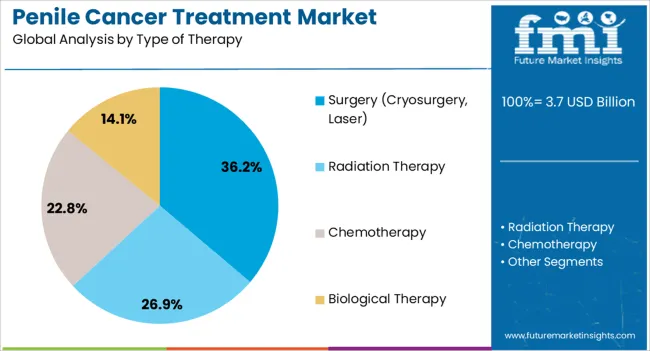
The surgery segment, which includes cryosurgery and laser-based procedures, is expected to represent 36.2% of the penile cancer treatment market revenue share in 2025, establishing it as the leading therapy type. This dominance is attributed to the role of surgery as the first-line treatment option for most penile cancer cases, especially in localized stages. Cryosurgery and laser therapies offer minimally invasive alternatives to conventional open surgery, reducing recovery time and lowering the risk of complications while preserving penile functionality.
The segment is being supported by advancements in surgical techniques and instruments that allow for higher precision and improved cosmetic as well as functional outcomes. Healthcare institutions are increasingly adopting these procedures due to their cost-effectiveness and efficiency in treating early-stage cancers.
Patient preference for less invasive interventions with reduced hospital stays is also driving demand for surgical therapies With the rising emphasis on early detection and immediate treatment, surgical interventions are expected to maintain their leadership position, providing a reliable and effective option for both patients and clinicians in managing penile cancer.
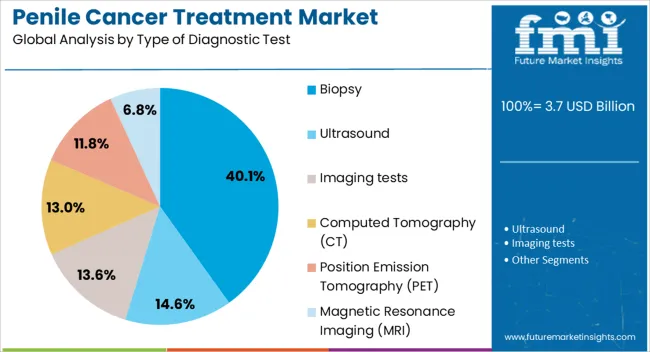
The biopsy segment is anticipated to hold 40.1% of the penile cancer treatment market revenue share in 2025, positioning it as the leading diagnostic test type. This leadership is primarily due to the biopsy’s definitive role in confirming penile cancer diagnoses, enabling accurate identification of cancer type and stage. Biopsy procedures provide critical pathological information that guides treatment decisions, ensuring personalized and targeted therapeutic approaches.
The reliability and widespread acceptance of biopsy as a gold standard in cancer diagnostics have reinforced its dominance in this market. Advances in biopsy techniques, including minimally invasive procedures, have improved patient comfort and reduced procedural risks, making it more accessible across healthcare settings. The segment is further supported by the growing awareness among clinicians and patients about the importance of early and precise cancer detection.
With the increasing emphasis on timely diagnosis and treatment planning, biopsies will continue to play a central role in the diagnostic pathway As global investments in oncology infrastructure grow, the biopsy segment is expected to maintain its leadership position as the cornerstone of penile cancer diagnosis.
According to research studies conducted by the American Cancer Society, patients suffering from squamous cell cancer of the penis, the most common penile malignancy, behave similarly to squamous cell cancer of other parts of the body.
Surgery is the most commonly used method of treating penile cancer. If cancer has spread to the bones, radiation therapy may be prescribed instead of surgery. In terms of therapy type segmentation, the radiation therapy segment is expected to generate the most revenue.
Chemotherapy is used to treat larger tumors or cancer that has spread to other parts of the body. MRI is the best way to get a clear picture of penile cancerous cells. At the initial stage of penile cancer diagnosis, an MRI is usually followed by a CT scan. PET is a relatively new technique used to assess the biological activity of tumors.
All these treatment methods are likely to propel market growth.
Due to an increasing population suffering from human immunodeficiency virus in countries such as India, Asia-Pacific is expected to be the dominant region in the global penile cancer market in the future. North America is expected to offer lucrative growth opportunities for the overall penile cancer treatment market because of the increasing prevalence of penile cancer patients in countries such as the United States and Canada, as well as the availability of cost-effective drugs in these countries.
The presence of developed healthcare infrastructure facilities in these countries may also contribute to the growth of the North American penile cancer treatment market.
The global penile cancer market is extremely competitive, with several well-established players present. Many of these players are expected to account for a significant portion of the overall market in the future. In the coming years, research and development activities could be a key growth strategy for the leading penile cancer market players.
Growth strategies such as new product launches could help well-established players in the penile cancer market gain a competitive advantage over their competitors. Novartis AG, GlaxoSmithKline PLC, Merck & Co Inc., Pfizer Inc., and F. Hoffmann-La Roche Ltd are some of the major players in the global penile cancer treatment market.
Merck & Co. Inc. launched a new vaccine against human papillomavirus called Gardasil 9 in 2025, which was approved by the FDA. This vaccine has shown promise in the treatment of cervical cancer, which may lead to penile cancer in men.
Increasing incidence of penile cancer is a major driver for the growth of global penile cancer treatment market. Advancement in technology coupled with personalized medicine, and cost effective treatment procedures for penile cancer will drive penile cancer market across the globe.
However, lack of inadequate reimbursement policies, healthcare literacy, and commercially less availability of drugs for the treatment of penile cancer are the factors which will hamper the growth of global penile cancer treatment market over the forecasted period.
Research studies conducted by American Cancer Society has shown that patients suffering with squamous cell cancer of penis, the most common penile malignancy, acts similarly to squamous cell cancer of other parts of body. Surgery is the most preferred way of treatment for penile cancer.
Radiation therapy can be prescribed instead of surgery if cancer has spread to the bones. Radiation therapy segment is expected to be the highest revenue generating in terms of therapy type segmentation. Chemotherapy is prescribed for some larger tumors or if the cancer has spread to other parts of body extensively.
MRI is a best way to understand exact picture of penile cancerous cells. MRI followed by CT scan is generally performed at initial stage of diagnosis of penile cancer. PET is comparatively new technique which is performed for screening the biological activity of tumor.
Biopsy should be performed in patients suffering with penile cancer with lesions.
Geographically, global breast biopsy device market is classified into regions viz. North America, Latin America, Western Europe, Eastern Europe, Asia Pacific Excluding Japan (APEJ), Japan, Middle East and Africa (MEA). APEJ followed by MEA dominates global penile cancer treatment market owing to large pool of patient suffering with HIV, and increasing awareness about penile cancer.
Thus, penile cancer treatment market in APEJ and MEA are expected to grow with significant CAGR over the forecasted period. However penile cancer incidences are rare in North America and Europe. According to American Cancer Society, penile cancer occurs in less than one man in 100, 000 and accounts for less than 1% of cancers in men in the SA
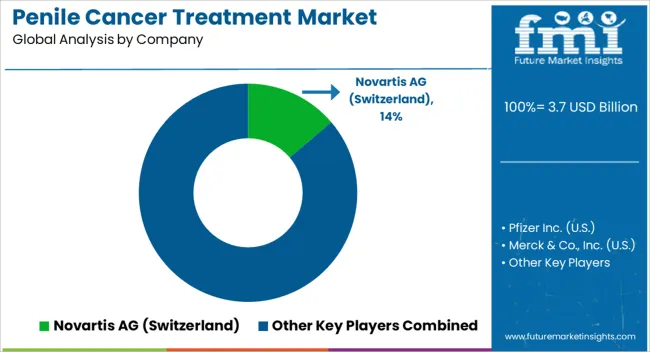
Key companies operational in global penile cancer treatment market include Merck & Co., Inc., GlaxoSmithKline plc, Pfizer Inc., Bristol-Myers Squibb Company, F. Hoffmann-La Roche Ltd, Novartis AG, and others.
The report is a compilation of first-hand information, qualitative and quantitative assessment by industry analysts, inputs from industry experts and industry participants across the value chain. The report provides in-depth analysis of parent market trends, macro-economic indicators and governing factors along with market attractiveness as per segments. The report also maps the qualitative impact of various market factors on market segments and geographies.
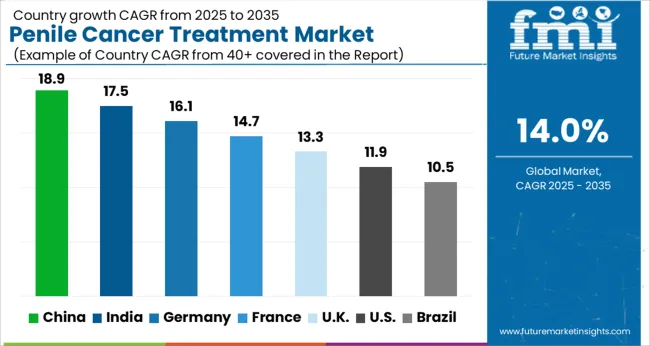
| Country | CAGR |
|---|---|
| China | 18.9% |
| India | 17.5% |
| Germany | 16.1% |
| France | 14.7% |
| UK | 13.3% |
| USA | 11.9% |
| Brazil | 10.5% |
The Penile Cancer Treatment Market is expected to register a CAGR of 14.0% during the forecast period, exhibiting varied country level momentum. China leads with the highest CAGR of 18.9%, followed by India at 17.5%. Developed markets such as Germany, France, and the UK. continue to expand steadily, while the USA is likely to grow at consistent rates. Brazil posts the lowest CAGR at 10.5%, yet still underscores a broadly positive trajectory for the global Penile Cancer Treatment Market. In 2024, Germany held a dominant revenue in the Western Europe market and is expected to grow with a CAGR of 16.1%. The USA Penile Cancer Treatment Market is estimated to be valued at USD 1.4 billion in 2025 and is anticipated to reach a valuation of USD 4.3 billion by 2035. Sales are projected to rise at a CAGR of 11.9% over the forecast period between 2025 and 2035. While Japan and South Korea markets are estimated to be valued at USD 193.5 million and USD 99.5 million respectively in 2025.
| Item | Value |
|---|---|
| Quantitative Units | USD 3.7 Billion |
| Type of Disease | Squamous cell cancer of penis, Adenocarcinoma of penis, Melanoma of the penis, Basal cell cancer of penis, and Sarcoma of penis |
| Type of Therapy | Surgery (Cryosurgery, Laser), Radiation Therapy, Chemotherapy, and Biological Therapy |
| Type of Diagnostic Test | Biopsy, Ultrasound, Imaging tests, Computed Tomography (CT), Position Emission Tomography (PET), and Magnetic Resonance Imaging (MRI) |
| Regions Covered | North America, Europe, Asia-Pacific, Latin America, Middle East & Africa |
| Country Covered | United States, Canada, Germany, France, United Kingdom, China, Japan, India, Brazil, South Africa |
| Key Companies Profiled | Novartis AG (Switzerland), Pfizer Inc. (USA), Merck & Co., Inc. (USA), F. Hoffmann-La Roche Ltd (Switzerland), Bristol-Myers Squibb (USA), Sanofi (France), GSK plc (UK), Cipla Inc. (India), Teva Pharmaceutical Industries Ltd (Israel), Fresenius Kabi AG (Germany), Intas Pharmaceuticals Ltd (India), and Mylan N.V. (USA) |
The global penile cancer treatment market is estimated to be valued at USD 3.7 billion in 2025.
The market size for the penile cancer treatment market is projected to reach USD 13.8 billion by 2035.
The penile cancer treatment market is expected to grow at a 14.0% CAGR between 2025 and 2035.
The key product types in penile cancer treatment market are squamous cell cancer of penis, adenocarcinoma of penis, melanoma of the penis, basal cell cancer of penis and sarcoma of penis.
In terms of type of therapy, surgery (cryosurgery, laser) segment to command 36.2% share in the penile cancer treatment market in 2025.






Our Research Products

The "Full Research Suite" delivers actionable market intel, deep dives on markets or technologies, so clients act faster, cut risk, and unlock growth.

The Leaderboard benchmarks and ranks top vendors, classifying them as Established Leaders, Leading Challengers, or Disruptors & Challengers.

Locates where complements amplify value and substitutes erode it, forecasting net impact by horizon

We deliver granular, decision-grade intel: market sizing, 5-year forecasts, pricing, adoption, usage, revenue, and operational KPIs—plus competitor tracking, regulation, and value chains—across 60 countries broadly.

Spot the shifts before they hit your P&L. We track inflection points, adoption curves, pricing moves, and ecosystem plays to show where demand is heading, why it is changing, and what to do next across high-growth markets and disruptive tech

Real-time reads of user behavior. We track shifting priorities, perceptions of today’s and next-gen services, and provider experience, then pace how fast tech moves from trial to adoption, blending buyer, consumer, and channel inputs with social signals (#WhySwitch, #UX).

Partner with our analyst team to build a custom report designed around your business priorities. From analysing market trends to assessing competitors or crafting bespoke datasets, we tailor insights to your needs.
Supplier Intelligence
Discovery & Profiling
Capacity & Footprint
Performance & Risk
Compliance & Governance
Commercial Readiness
Who Supplies Whom
Scorecards & Shortlists
Playbooks & Docs
Category Intelligence
Definition & Scope
Demand & Use Cases
Cost Drivers
Market Structure
Supply Chain Map
Trade & Policy
Operating Norms
Deliverables
Buyer Intelligence
Account Basics
Spend & Scope
Procurement Model
Vendor Requirements
Terms & Policies
Entry Strategy
Pain Points & Triggers
Outputs
Pricing Analysis
Benchmarks
Trends
Should-Cost
Indexation
Landed Cost
Commercial Terms
Deliverables
Brand Analysis
Positioning & Value Prop
Share & Presence
Customer Evidence
Go-to-Market
Digital & Reputation
Compliance & Trust
KPIs & Gaps
Outputs
Full Research Suite comprises of:
Market outlook & trends analysis
Interviews & case studies
Strategic recommendations
Vendor profiles & capabilities analysis
5-year forecasts
8 regions and 60+ country-level data splits
Market segment data splits
12 months of continuous data updates
DELIVERED AS:
PDF EXCEL ONLINE
Blood Cancer Treatment Market Growth – Trends & Forecast 2025 to 2035
Glottic Cancer Treatment Market
Cervical Cancer Treatment Market Size and Share Forecast Outlook 2025 to 2035
Testicular Cancer Treatment Market
Endometrial Cancer Treatment Market Size and Share Forecast Outlook 2025 to 2035
Biliary Tract Cancers Treatment Market Analysis - Size, Share, and Forecast Outlook 2025 to 2035
Key Players & Market Share in the Biliary Tract Cancers (BTCs) Treatment Industry
Small Cell Lung Cancer (SCLC) Treatment Market Size and Share Forecast Outlook 2025 to 2035
Kinase Inhibitors For Cancer Treatment Market Size and Share Forecast Outlook 2025 to 2035
PD1 Non-Small Cell Lung Cancer Treatment Market - Growth & Outlook 2025 to 2035
Japan Biliary Tract Cancers (BTCs) Treatment Market Growth – Demand, Trends & Forecast 2025-2035
China Biliary Tract Cancers (BTCs) Treatment Market Analysis – Size, Share & Forecast 2025-2035
Germany Biliary Tract Cancers (BTCs) Treatment Market Trends – Demand, Innovations & Forecast 2025-2035
Adoptive Cell Therapy for Cancer Treatment Market
Australia Biliary Tract Cancers (BTCs) Treatment Market Insights – Size, Share & Industry Growth 2025-2035
United States Biliary Tract Cancers (BTCs) Treatment Market Analysis – Size, Share & Trends 2025-2035
Castration-Resistant Prostate Cancer (CRPC) Treatment Market Insights - Demand, Size & Industry Trends 2025 to 2035
Hormone Sensitive Advanced Prostate Cancer Treatment Market Size and Share Forecast Outlook 2025 to 2035
Cancer Registry Software Market Size and Share Forecast Outlook 2025 to 2035
Cancer Biological Therapy Market Size and Share Forecast Outlook 2025 to 2035

Thank you!
You will receive an email from our Business Development Manager. Please be sure to check your SPAM/JUNK folder too.
Chat With
MaRIA